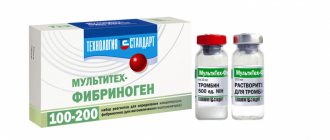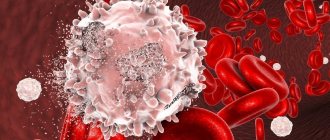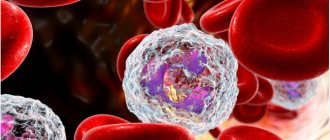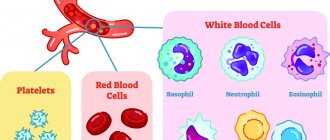There are six types of neutrophils depending on the stage of their maturation. Immature types include myeloblasts, promyelocytes, myelocytes, metamyelocytes and band cells. The final stage of development is segmented neutrophils (mature cells with a formed nucleus, divided into several segments).
Even at the stages of their initial development, neutrophils are able to resist infection, although mature segmented cells cope with this task much more effectively.
In blood tests of people suffering from severe infectious diseases, immature forms of neutrophils can be detected. This is explained by the fact that in the fight against pathogenic microorganisms, segmented cells die too quickly, and therefore the body is forced to use cells that are not fully mature. But in the blood of a healthy person, predominantly mature neutrophils are found, since they cope well with their task with virtually no help from their young brothers.
Figure 1. Phagocytosis. Image: mikrostoker/Depositphotos
Blood test for neutrophils
To determine the level of neutrophils, a complete blood count is used. To designate neutrophils on the analysis form, the Latin abbreviation NEUT is used, which can be expressed either in absolute (cell content per liter of blood, for example 0.04-0.3 × 109) or as a percentage. For general analysis, capillary blood is usually used. The biomaterial is collected from a finger after puncture with a scarifier. Sometimes blood is drawn from a vein - much depends on the methods the laboratory uses.
Neutrophils, leukocytes and the immune system
It can be confusing when you hear doctors talk about white blood cells and neutrophils. If neutrophils are only one type of white blood cell, then why do oncologists talk about both low white blood cell count and low neutrophil count during chemotherapy (chemotherapy-induced neutropenia)? The answer is that low neutrophil levels may be the most dangerous factor in predisposing people to infections.
All blood cells (white blood cells, red blood cells, and platelets) are made in bone marrow , the spongy tissue in the central region of bones such as the femur. In the bone marrow, all of these cells arise as one type of cell known as hematopoietic stem cells.
These stem cells then differentiate into different cell types in a process known as hematopoiesis. Because all of these cells begin as a common stem cell, processes that damage the bone marrow, such as chemotherapy, often affect all types of blood cells. This is called bone marrow suppression during chemotherapy.
In addition to erythrocytes (red blood cells) and platelets, there are several types of white blood cells. White blood cells develop along two different lines. Stem cells can develop either along the lymphoid lineage, leading to the eventual formation of T lymphocytes and B lymphocytes, or along the myeloid lineage. A cell in the myeloid lineage can develop into a neutrophilic, eosinophilic, monocytic, or basophilic cell.
Differentiation of common myeloid progenitor cells. Neutrophil maturation. (source) Neutrophils begin as myeloblasts, which mature into promyelocytes, myelocytes, metamyelocytes, and then mature neutrophils. (7)
Indications for analysis
A general blood test is the most common hematological test, so the range of indications for its use is wide. Neutrophils are a type of white blood cell whose main task is to destroy pathogenic microorganisms. Therefore, the main goal of the analysis for the content of neutrophils is to identify potentially dangerous conditions accompanied by infectious and inflammatory processes. In other words, a blood test for neutrophils can be informative both for colds and for kidney or liver diseases.
Origin of neutrophils:
Neutrophils come from the red bone marrow; they are formed there from a single stem cell, which is the ancestor of all the formed elements of blood. True, stem cells do not immediately transform into neutrophils. Between these two forms there are several stages, several transitional forms. And even when gradual transformations lead to the formation of neutrophils themselves with all their inherent characteristics, among them there still remains a number of species representing several successive degrees of maturity.
There are 6 types of neutrophils in total.
1. Myeloblast
2. Promyelocyte
3. Myelocyte
4. Metamyelocyte (young neutrophils)
5. Band neutrophils Metamyelocyte is one of the transitional forms of neutrophils
6. Segmented neutrophils.
Most of all is in the blood of the latter. They are present in it in the amount of 40-75% of the total number of leukocytes. The number of band neutrophils is much smaller; they can be 1-6%. Young cells are rare, their number does not even reach 1%, usually they are not even counted in a blood test. All other neutrophils are not found in the bloodstream at all and “live” in the bone marrow, where they prepare to become more mature forms.
All of the listed varieties (and in fact, only the last three) represent the so-called leukocyte formula. Normally, the ratio of these cells is as indicated above. However, for some diseases the formula may change.
A condition in which segmented neutrophils (that is, old cells) increase in the blood is called a shift in the leukocyte formula to the right. The opposite situation, in which the proportion of young and rod-shaped neutrophils (young forms) increases, is called a shift of the formula to the left. This or that shift is a sign of certain diseases; this will be discussed in more detail in the article “Leukocyte Formula”.
Preparing for analysis
The study is carried out in the morning on an empty stomach, since food intake causes an increase in the number of neutrophils in the blood. Dinner on the eve of the test is allowed no later than eight o'clock in the evening. 2 days before the study, the patient should follow the following preparation rules:
- stop drinking alcohol;
- limit the consumption of spicy, fried and fatty foods;
- Avoid heavy physical activity and nervous stress.
The morning before the test you should not smoke. It is allowed to drink pure still water.
Figure 2. Preparation for donating blood for analysis.
Segmented neutrophils are reduced - possible reasons
A decrease in the number of neutrophils in the blood most often indicates a protracted course of some disease of viral etiology. These cells do not stay in the bloodstream for long. As they mature, they transform from rod-nuclear to segmented, and within 2-3 hours they leave the bloodstream, concentrating in inflamed tissues.
If the human body has not been subjected to any complex or immune-suppressing procedures, then we can assume:
- severe viral infection, such as measles or rubella.
- allergic reaction;
- infection after a bite, for example, malaria;
- presence of helminths;
- hereditary pathology.
In addition, neutrophils in the blood decrease as a result of:
- radioactive exposure;
- taking a certain group of medications;
- undergoing chemotherapy;
- exposure to exotoxins, poisons and certain chemicals on the body.
To make an accurate diagnosis, it is necessary not only to donate blood for analysis, but also to obtain a conclusion from the doctor conducting the examination. The presence of helminths is easily determined using laboratory tests, and infection with malaria should be preceded by a trip to an exotic country and a local insect bite. Therefore, the results of a blood test are not a diagnosis, but a reason to undergo a more in-depth examination to identify or refute a low neutrophil count.
However, with the help of a blood test, it is easier for the doctor to determine the etiology of the disease if the patient comes with complaints about the severity of any symptoms. For example, if the transcript indicates that segmented neutrophils are lower and lymphocytes are higher than normal, this will indicate that the patient has contracted a viral infection and does not need antibacterial therapy.
Normal levels of neutrophils in the blood
The number of neutrophils in the blood is approximately 40-70% of the total leukocyte mass in both men and women.
When conducting research, experts primarily pay attention to the content of neutrophils at the middle and full stages of maturation, that is, band and segmented forms. Young cells are of interest if the development of the spread of inflammatory processes is suspected. The table shows the leukocyte formula, which reflects, among other things, the number of neutrophils. Table 1. Leukocyte formula with the number of neutrophils
| Index | × 10x9/l | Share as a percentage of the number of leukocytes | |
| Neutrophils | segmented | 2.0 – 5.5 | 40 — 70 |
| stab | 0.4 – 0.3 | 1 — 5 | |
| Basophils | Within 0.062 | Within 1.0 | |
| Eosinophils | 0.02 – 0.3 | 0.5 — 5 | |
| Lymphocytes | 1.0 – 3.2 | 17 — 38 | |
| Monocytes | 0.07 – 0.5 | 3 — 12 | |
In children of the first year of life, the number of band neutrophils can reach five, then the maximum value is limited to four, as in adults. The smallest number of segmented neutrophils is observed in children 4-5 years old (35-55%). In other age groups it varies between 40-70%.
What are neutrophils?
Neutrophils, also called polymorphonuclear leukocytes, are white blood cells that protect our body from bacterial, fungal and other similar infections. () Neutrophils are clearly visible under a microscope in the form of cells with characteristic 2-5 lobes in the nucleus. ()
They have practically no effect against viruses; for this, there are other immune cells - cytotoxic CD8+ lymphocytes and NK killers.
Neutrophils make up approximately 40-60% of all white blood cells in our body, and are the first immune cells to be activated when we get a bacterial infection. () Neutrophils contain granules that are important for antimicrobial action. ()
Damage to cells in our body (by injury or infection) results in the production of “chemokines” that attract neutrophils to the affected area in a process called chemotaxis. Neutrophils are known to you in practice as the primary component of pus in any wound.
LEUCOCYTES, NEUTROPHILS AND OTHER BLOOD CELLS ARE PRODUCED INSIDE THE BONE MARROW
However, they have a very short lifespan. Neutrophils live in the blood for about 8 hours and undergo automatic self-destruction after this time so that inflammation does not accumulate in the body. () But our bodies produce approximately 100 billion of these cells every day.
Once matured and released from the bone marrow, about 50% of these cells are present along the walls of blood vessels, and the other half are found in body tissues.
Causes of increased neutrophils in the blood
Elevated neutrophil levels can indicate a wide range of illnesses and injuries. Very often, the cause of an increase in neutrophils in the blood is infectious processes of bacterial origin, which can be either focal or generalized (spread throughout the body).
Reasons for increasing the level of neutrophils in the blood:
- upper respiratory tract infections (laryngitis, pharyngitis, sore throat);
- pneumonia;
- kidney diseases;
- diseases of the cardiovascular system;
- local purulent-inflammatory foci (abscesses, abscesses);
- viral diseases (measles, mumps, chickenpox, rubella, etc.);
- oncological diseases;
- taking hormonal medications;
- infections of bacterial origin (dysentery, tuberculosis, cholera, anthrax, etc.);
- poisoning with toxic substances;
- processes of tissue necrosis (gangrene, myocardial infarction, major burns);
- injuries of large organs;
- fractures;
- damage to the skin (cuts, abrasions, etc.);
- gout;
- sepsis (blood poisoning).
Eating canned foods can also cause an increase in neutrophils. This applies to those products in which there are no longer living bacteria left, but the toxic products of their vital activity have been preserved.
REASONS FOR HIGH AND LOW LEVELS
There are many different reasons why a person may have high or lower than normal levels of neutrophils in their blood.
HIGH LEVEL
An abnormally high level of neutrophils in the blood is known as neutrophilic leukocytosis or neutrophilia.
Increased neutrophil levels usually occur naturally due to infections and injuries. However, the level of neutrophils in the blood may also increase in response to:
- Certain medications, such as a corticosteroid, beta-2 agonist, and epinephrine
- Some types of cancer
- Physical and emotional stress
- Surgeries and accidents
- Smoking tobacco
- Pregnancy
- Obesity
- Genetic diseases such as Down syndrome
- Surgical removal of the spleen
Some inflammatory conditions can increase neutrophil levels, such as rheumatoid arthritis, inflammatory stomach syndrome, hepatitis, and inflammation of the blood vessels.
LOW LEVEL
An abnormally low level of neutrophils is a condition called neutropenia.
Low levels of neutrophils in the blood usually occur when the body uses up immune cells faster than it can produce them or if the bone marrow does not produce them correctly.
An enlarged spleen can also cause low neutrophil levels because the spleen absorbs and destroys neutrophils and other blood cells.
Some conditions that cause the body to use up neutrophils quite quickly include:
- Severe or chronic bacterial infections
- Allergic diseases
- Some medications
- Autoimmune diseases
Some special conditions and surgeries, as well as medications, that interfere with neutrophil production include:
- Cancer
- Viral infections such as influenza
- Bacterial infections such as tuberculosis
- Myelofibrosis, a disease that results in fibrosis of the bone marrow
- Vitamin B-12 deficiency
- Radiotherapy affecting the bone marrow
- Phenytoin and sulfa drugs
- Chemotherapy drugs
- Toxins such as benzene and insecticides
- Aplastic anemia, when the bone marrow stops producing enough blood cells
- Severe hereditary agranulocytosis, a group of diseases in which neutrophils fail to grow
- Cyclic neuropenia, which causes cell levels to rise and fall
- Chronic benign neuropenia, which causes low cell counts for no apparent reason.
TESTING
Doctors can detect changes in neutrophil levels with a blood test called a complete blood count with leukogram, which identifies specific groups of white blood cells.
Doctors may order this type of test if a patient has a number of symptoms related to infection, chronic illness, and injury, such as fever, pain, and exhaustion. A nurse or lab technician will take a small sample of blood from your arm and send it for testing.
If the initial test shows a higher or lower white blood cell count than normal, the test will likely be repeated to confirm the results. If the initial results are confirmed, the doctor will perform a physical test, ask questions about the patient's lifestyle, and review his medical history.
If there is no obvious reason for changes in white blood cell levels, your doctor will order a special test. A laboratory specialist will examine the blood for special leukocytes, such as young neutrophils, or otherwise myeoblasts. During infection or chronic disease, these cells may escape the bone marrow and grow in the blood rather than in the bone marrow.
If myeoblasts and other white blood cells appear at certain levels in the blood, the doctor will request a bone marrow sample.
Taking a bone sample involves inserting a long needle into a part of the pelvis near the back of the thigh. The procedure can be extremely painful, and a doctor usually performs the procedure in a hospital using local anesthesia.
Experts examine a sample of bone marrow to see if neutrophils and other blood cells are developing properly and getting the right nutrition.
If the cause of the elevated or decreased levels is still not clear, your doctor will order other tests to determine the cause of the changes, such as:
- CT scan
- Blood culture
- Analysis of urine
- Fluorography of the chest
RESULTS
Changes in neutrophil levels are often a sign of more significant changes in white blood cell levels.
The number and size of white blood cells in the bloodstream change with age and for other reasons, such as pregnancy. While the normal varies slightly from person to person, it is generally:
- Newborns: 13,000 – 38,000 per cubic millimeter
- Newborns 2 weeks old: 5,000-20,000 per cubic millimeter
- Adults: 4,500 – 11,000 per cubic millimeter
- Pregnant women (3rd trimester): 5,800 – 13,200 per cubic millimeter
In adults, if the white blood cells exceed 11,000 per cubic millimeter, it is called leukocytosis, which is considered elevated.
Neutrophilic leukocytosis occurs when a person has a level of mature neutrophils in the bloodstream exceeding 7,000 per cubic millimeter.
The lowest level of neutrophils in the human body is 1,500 per cubic millimeter. When a person has low neutrophil levels, it is known as neuropenia. The lower the level of neutrophils in the blood, the more severe the neuropenia. The levels of neuropenia are:
- Mild neuropenia: 1,000 – 1,500 per cubic millimeter
- Average neuropenia: 500 – 999 per cubic millimeter
- Severe neuropenia: 200-499 per cubic millimeter
- Extremely severe neuropenia: below 200 per cubic millimeter
Small changes in the level of neutrophils or white blood cells are not a cause for concern if they are temporary. An elevated white blood cell count most often means the body is responding to an infection, injury, or stress.
Some people naturally have lower white blood cell and neutrophil levels than others due to various factors, including congenital conditions.
If your neutrophil and white blood cell levels change for no apparent reason or remain elevated or low, your doctor will order more tests to determine the cause.
Very high or low white blood cell counts often require emergency treatment and regular monitoring. People with severe neuropenia will not have adequate protection against infections.
People with severe neutrophilia usually have a type of life-threatening infection or inflammatory disease that requires treatment, such as cancer.
HOW TO INCREASE AND DECREASE NEUTROPHIL LEVELS
The best way to correct abnormal neutrophil levels is to treat the underlying cause.
Antibiotics treat bacterial infections, while antifungal medications only treat fungal infections. People can treat some viral infections with medications that reduce viral activity. On the other hand, supportive care such as drinking enough fluids and rest may be part of the treatment plan.
People with elevated neutrophil levels caused by medications or procedures should stop or change treatment.
People with chronic diseases that interfere with normal neutrophil production or maturation may need to take medications that allow the body to increase neutrophil production, such as:
- Colony-stimulating factors
- Corticosteroids
- Antimocyte globulin
- Bone marrow or stem cell transplant
People with low neutrophil levels often require observation, treatment with antibiotics, and hospitalization to reduce the risk of severe infection.
This period of intensive care helps protect people with weakened immune systems from potentially dangerous microorganisms. It also supports the body by giving it more time to produce more white blood cells.
One of the reasons for low neutrophil levels is a lack of vitamin B-12. Eating foods rich in vitamin B-12 helps improve low neutrophil levels. Foods rich in vitamin B-12:
- Eggs
- Milk and dairy products
- Meat
- Fish
- Bird
- Many vitamin-fortified breakfast cereals and bread products
- Nutritional yeast
To reduce your risk of high or low neutrophil counts, you can try the following:
- Don't overdo it with sports
- Reduce stress levels and treat chronic and severe stress
- Contact your doctor at the first sign of infection, such as fever, weakness, fatigue, or pain
- Follow a healthy, balanced diet
- There is a sufficient amount of protein
- Treat chronic conditions such as genetic or inflammatory diseases
However, people with minor changes in neutrophil levels often have no symptoms and do not require any treatment.
Causes of low levels of neutrophils in the blood
A decrease in the level of neutrophils in the blood is called neutropenia. The cause of this phenomenon can be diseases of various natures, as well as taking various medications.
Reasons for decreased neutrophil levels:
- infectious diseases (viral hepatitis, typhus, influenza, mononucleosis, etc.);
- autoimmune diseases (rheumatoid arthritis, systemic vasculitis, Crohn's disease, etc.);
- radiation sickness;
- blood diseases (leukemia, hemolytic and dyserythropoietic anemia).
Separate mention should be made of medications: taking them can also cause neutropenia. This is a very broad group of medications, which includes:
- NSAIDs (non-steroidal anti-inflammatory drugs: analgin, amidopyrine);
- antibacterial drugs (cephalosporins, penicillins);
- drugs to lower sugar (chlorpropamide);
- thyreostatic agents (propylthiouracil, Mercazolil);
- antimalarial drugs of synthetic origin (hydroxychloroquine);
- sulfonamides (sulfapyrazone; sulfasalazine);
- cytostatics (chlorambucil, methotrexate);
- antivirals (ganciclovir, zidovudine).
Figure 3. Blood cells in a healthy person and with neutropenia. Image: Sakurra/Depositphotos
Normal neutrophil count
The healthy range for neutrophils is about 1.5 – 8 x 10*9/L, or 1500 – 8000 cells/microliter. Normal neutrophil levels are usually between 2500 and 7500 neutrophils per microliter. () Neutrophils may normally be slightly higher during pregnancy. ()
The number and proportion of white blood cells in the bloodstream change with time of day, age and other events, such as pregnancy. Although the normal range varies slightly between laboratories, commonly used normal ranges indicate the neutrophil count:
- Newborn baby : 13,000 – 38,000 cells/microliter
- Baby 2 weeks of age : 5,000 – 20,000 cells/microliter
- Adult : 4,500 – 11,000 cells/microliter
- Pregnant woman (third trimester): 5,800 – 13,200 cells/microliter
When in adults (women without pregnancy) the number of white blood cells in the blood exceeds 11,000 cells/microliter (or 11 x 10*9 /l), it is called leukocytosis , which is an increased level of white blood cells. Neutrophilic leukocytosis occurs when a person has more than 7,000 mature neutrophils in a microliter of their bloodstream.
Neutropenia
A neutrophil level of less than 1500 cells/microliter is called neutropenia , although the degree of reduction is important. The number of neutrophils is less than 1000 units. is the most serious condition and may carry serious risks of developing infections. ()
Neutropenia Levels:
- Mild neutropenia: 1,000 – 1,500 cells/microliter or 1.0 – 1.5 x 10*9/l
- Moderate neutropenia: 500 – 999 cells/microliter
- Severe neutropenia: 200 – 499 cells/microliter
- Very severe neutropenia: below 200 cells/microliter
Minor changes in the level of neutrophils or white blood cells are usually not a cause for concern as long as they are temporary. An elevated white blood cell count often means the body is responding to infection, injury, or psychological stress.
Appearance of neutrophils
The appearance of neutrophils, or their “morphology,” can also be useful in diagnosing diseases. While a complete blood count determines the number of white blood cells, a peripheral blood smear for morphology is often done to see specific characteristics that may be present in neutrophils. For example, toxic granulations can be observed in neutrophils during serious infections, hypersegmented neutrophils (more than 5 lobes) can be observed in vitamin B12 deficiency or folate deficiency, etc.
The mechanisms of neutrophil attack during inflammation have been studied. In activated neutrophils, the main mechanisms responsible for inflammation are respiratory burst, degranulation and the formation of neutrophil extracellular traps (nets). During the respiratory burst, neutrophils use oxygen to produce reactive oxygen species (ROS) such as superoxide (O-2), peroxide H2O2, or hypochlorous acid (HOCl) by activating NADPH oxidase (NOX2) and myeloperoxidase (MPO). (source)
Immature neutrophils in the blood
Most of the neutrophils in our blood are mature neutrophils. Immature neutrophils may be found on a blood smear if the body is under stress and there is a strong need for more neutrophils. When this occurs, increased numbers of immature neutrophils may enter the blood from the bone marrow before reaching maturity.
Additionally, increased production of immature neutrophils can occur in conditions such as myelodysplastic syndromes and leukemias , such as acute promyelocytic leukemia. (12)
Consequences of deviation of neutrophils from the norm
A change in the level of neutrophils in the blood is a signal from the body about the presence of inflammatory diseases, injuries or poisoning. Therefore, it is necessary to accurately determine the cause of the increase or decrease in neutrophils in order to begin treatment in time or eliminate the provoking factor. If this is not done on time, the consequences can be severe (even death). The greatest danger among possible causes is infectious diseases of a bacterial nature, as well as processes of local suppuration and necrotization (death) of tissue.
Structure of neutrophils:
When the level of neutrophils is normal and a person is healthy, only band and segmented cells are found in his blood, so we will describe them. The size of the former is slightly larger, 11-12 microns, and the latter is slightly smaller - 8-10 microns. Sometimes there are very small forms of neutrophils, reaching 7-8 microns, or very large ones, 15-20 microns, but there are very few of them.
A microscope shows that the majority of any neutrophil is occupied by cytoplasm - the internal contents of the cell. When a blood smear in which neutrophils are studied is stained with standard dyes, it becomes clear that granularity is well defined within the cytoplasm. Moreover, the norm for neutrophils is pinkish cytoplasm and purple granularity in it.
The nuclei of the two described forms of cells are different, and based on the characteristics of the nuclei, different types of neutrophils are given their names. Rod cells have an elongated nucleus, which is presented in the form of a straight or curved rod. In segmented cells, the nucleus is divided into several (2-4) unequal “pieces”, segments, interconnected by constrictions.
How to reduce the number of neutrophils in the blood
To reduce the number of neutrophils in the blood, it is necessary to influence the cause of this phenomenon, since there are no separate ways to eliminate it. If the increase in neutrophil levels is caused by short-term stress or increased physical activity, then no specific correction is required.
For persistent neutrophilia, depending on the disease that caused it, the following treatment methods are used:
- antimicrobial therapy - antibiotics are used for infections (amoxicillin, cefixime);
- antiplatelet therapy - in case of heart attack and a tendency to blood clots, acetylsalicylic acid and alteplase are prescribed;
- anti-inflammatory therapy - glucocorticosteroids (prednisolone) are used to reduce inflammation that provokes neutrophilia;
- chemotherapy – aimed at combating malignant tumors (cytostatics, antimetabolites).
If there is a local focus of inflammation, surgical treatment can be used. For example, it is relevant for appendicitis or abscesses. The menu should limit the amount of meat products, canned and smoked. The diet should be rich in vegetables and fruits.
To normalize the level of neutrophils in the blood, it is recommended to eat more vegetables and fruits. Photo: sommail / freepik.com
How to increase the number of neutrophils in the blood
To correct neutropenia, it is necessary to identify its cause. If a decrease in neutrophil levels is caused by taking medications, you should first weigh the possible risks of a decrease in neutrophil levels with the importance of the therapeutic effect of the drugs used. In extreme cases, the drug can be replaced with an analogue that does not affect the level of neutrophils in the blood. The underlying diseases that cause neutropenia are treated with antibiotics, anti-inflammatory and antiviral drugs.
It is recommended to consume the following products:
- any meat dishes (it is important that they are all well thermally processed);
- hard boiled eggs;
- pasteurized milk;
- cheese (except for varieties with mold);
- potato;
- rice;
- pasta;
- fruits and vegetables;
- alcohol only in consultation with a doctor.
Careful heat treatment of meat and eggs is necessary in order to exclude the possibility of bacteria and microbes entering the body, which actively multiply in poorly fried or undercooked protein dishes.











